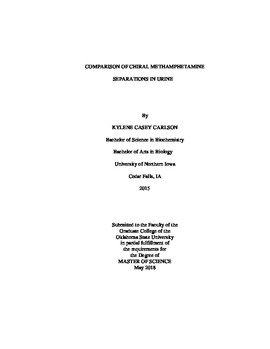| dc.contributor.advisor | Wagner, Jarrad R. | |
| dc.contributor.author | Carlson, Kylene Casey | |
| dc.date.accessioned | 2019-03-29T15:39:49Z | |
| dc.date.available | 2019-03-29T15:39:49Z | |
| dc.date.issued | 2018-05-01 | |
| dc.identifier.uri | https://hdl.handle.net/11244/317793 | |
| dc.description.abstract | Methamphetamine (meth) and amphetamine are commonly abused central nervous system (CNS) stimulants that are frequently screened for in many forensic and clinical toxicology labs. Amphetamine is present as the metabolite of methamphetamine, but also may be taken directly. These drugs exist in two chiral forms, d- and l-, called enantiomers. d-Meth is physiologically more reactive in the CNS, affecting the dopamine system and making it more likely to be abused. l-Meth is commonly found in nasal decongestants, as it has more peripheral nervous system (PNS) effects and less CNS stimulant effects than d-meth. For these reasons, d-meth is commonly abused and obtained illegally, while l-meth may be legally obtained in over the counter (OTC) nasal decongestant products. | |
| dc.description.abstract | Most drug testing laboratories used liquid chromatography with tandem mass spectrometry (LC-MS/MS) to confirm the presence of methamphetamine and amphetamine, but this doesn't typically differentiate between the enantiomers. As there is utility in understanding whether the methamphetamine in a urine specimen is from a licit or illicit source, it would be useful to develop screening methods that can differentiate between the d- and l- enantiomers in forensic and clinical toxicology labs. | |
| dc.description.abstract | In this research, a simple and cost-effective LC-MS/MS chiral separation method was developed to separate d- and l-enantiomers of methamphetamine and amphetamine. Separation methods using a chiral column with either solid phase extraction or dilute and shoot specimen preparation were developed and successfully applied to research specimens. The differentiation of enantiomers using an achiral column and a pre-column derivatization with Marfey's reagent was also researched, but the derivatives were challenging to detect in the LC-MS/MS. The successful chiral column extraction methods were applied to five (5) anonymized urine samples in a single-blind test, four negatives and one positive for methamphetamine, and it was possible to identify both d-methamphetamine and d-amphetamine. | |
| dc.format | application/pdf | |
| dc.language | en_US | |
| dc.rights | Copyright is held by the author who has granted the Oklahoma State University Library the non-exclusive right to share this material in its institutional repository. Contact Digital Library Services at lib-dls@okstate.edu or 405-744-9161 for the permission policy on the use, reproduction or distribution of this material. | |
| dc.title | Comparison of Chiral Methamphetamine Separations in Urine | |
| dc.contributor.committeeMember | Veitenheimer, Allison | |
| dc.contributor.committeeMember | Thrasher, Ronald R. | |
| osu.filename | Carlson_okstate_0664M_15731.pdf | |
| osu.accesstype | Open Access | |
| dc.description.department | Forensic Sciences | |
| dc.type.genre | Thesis | |
| dc.type.material | text | |
